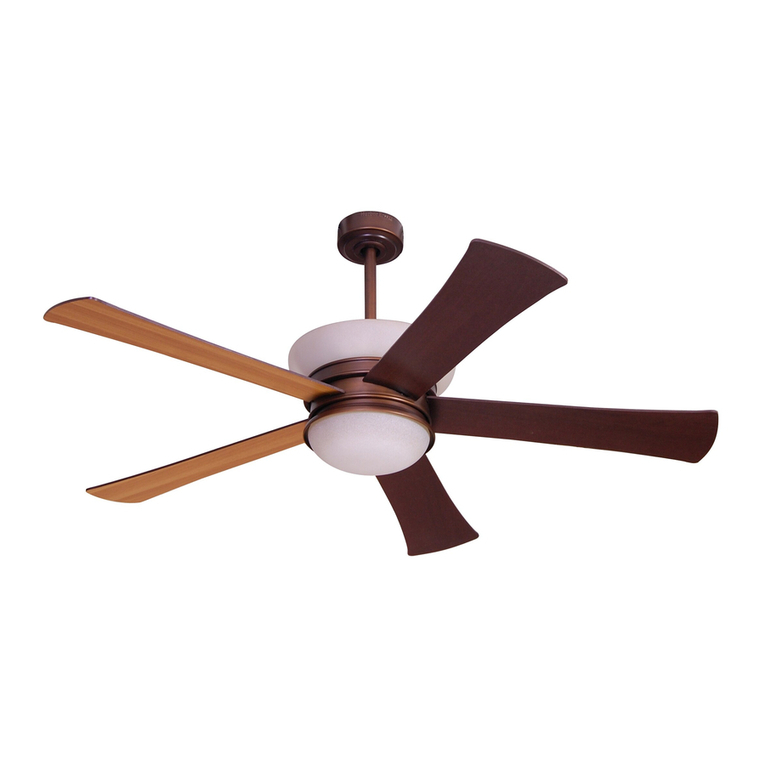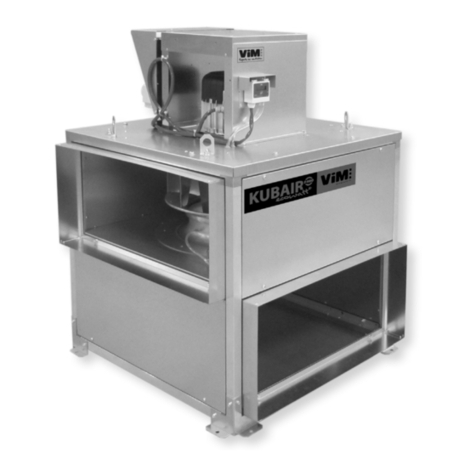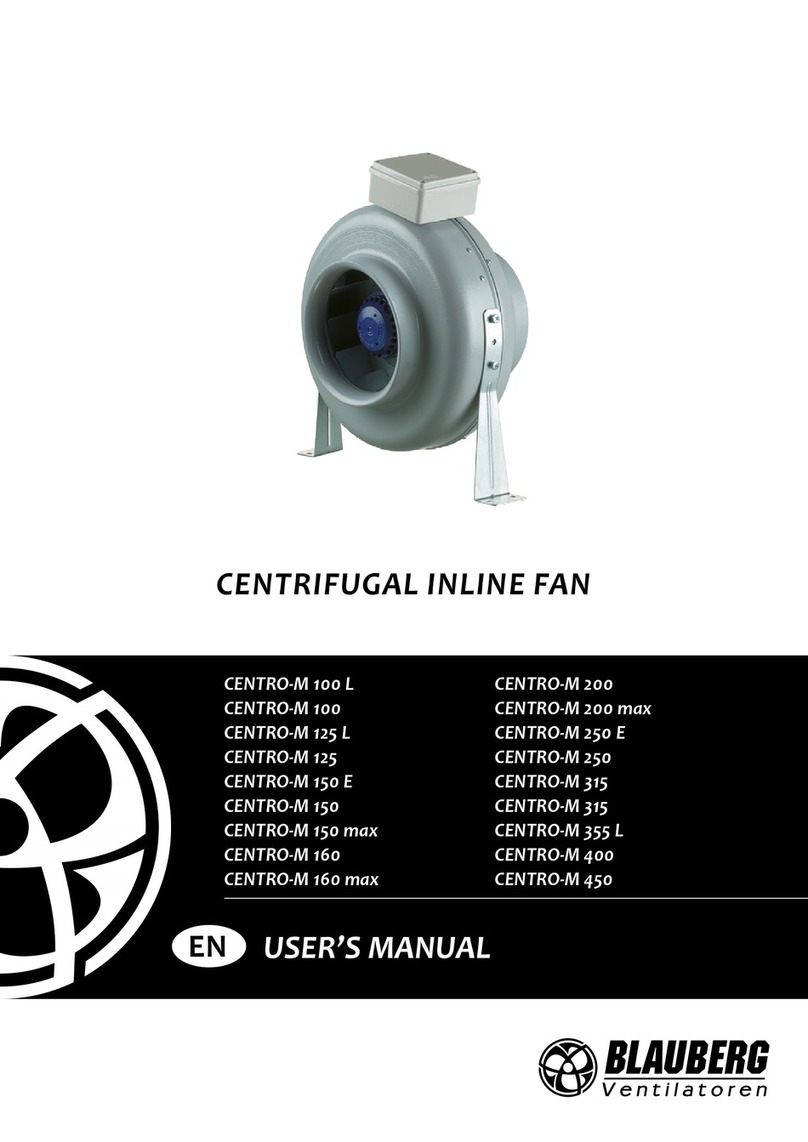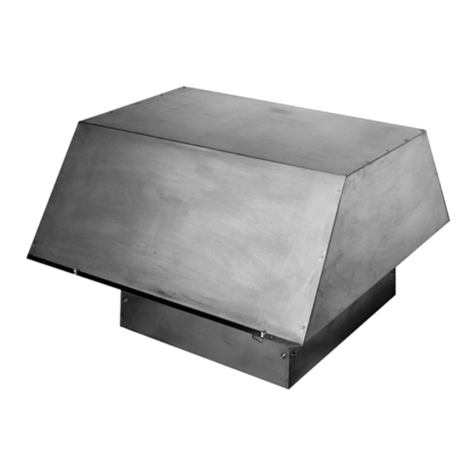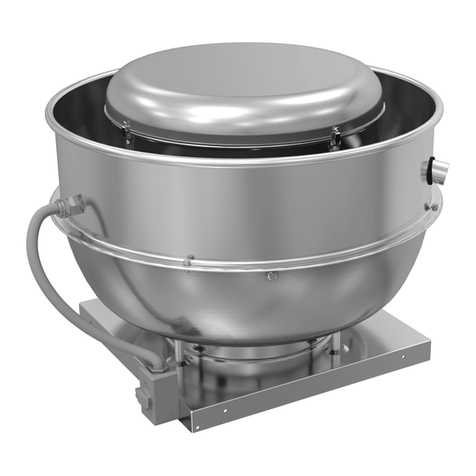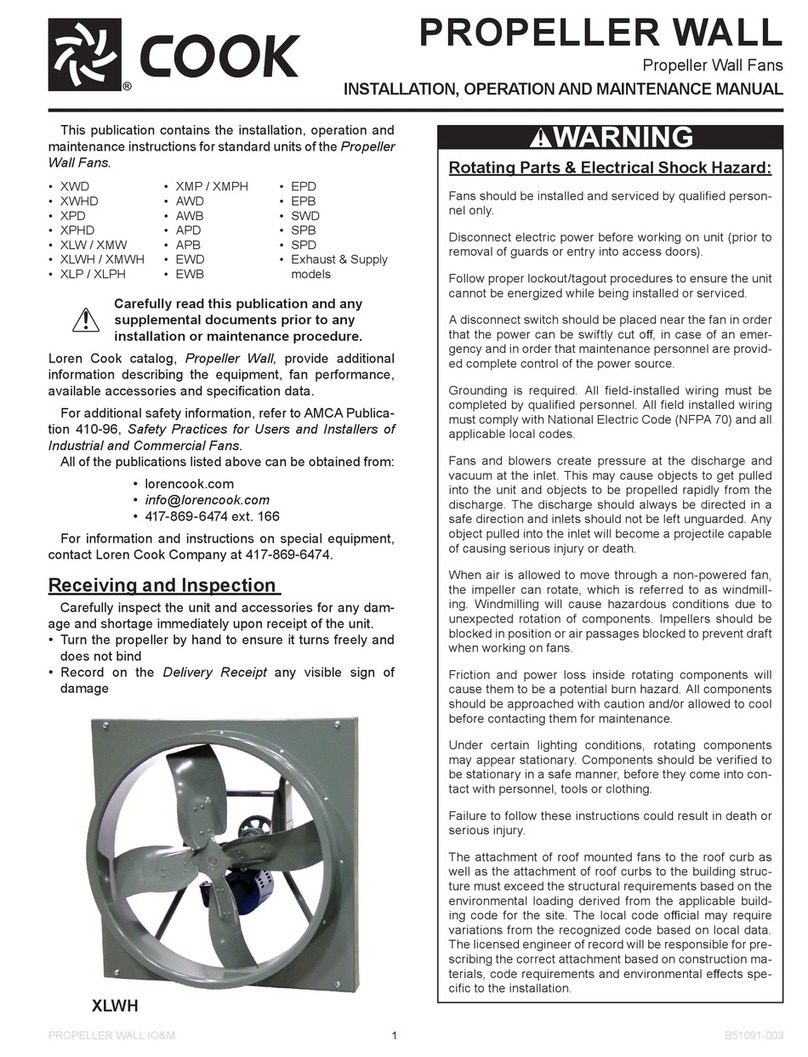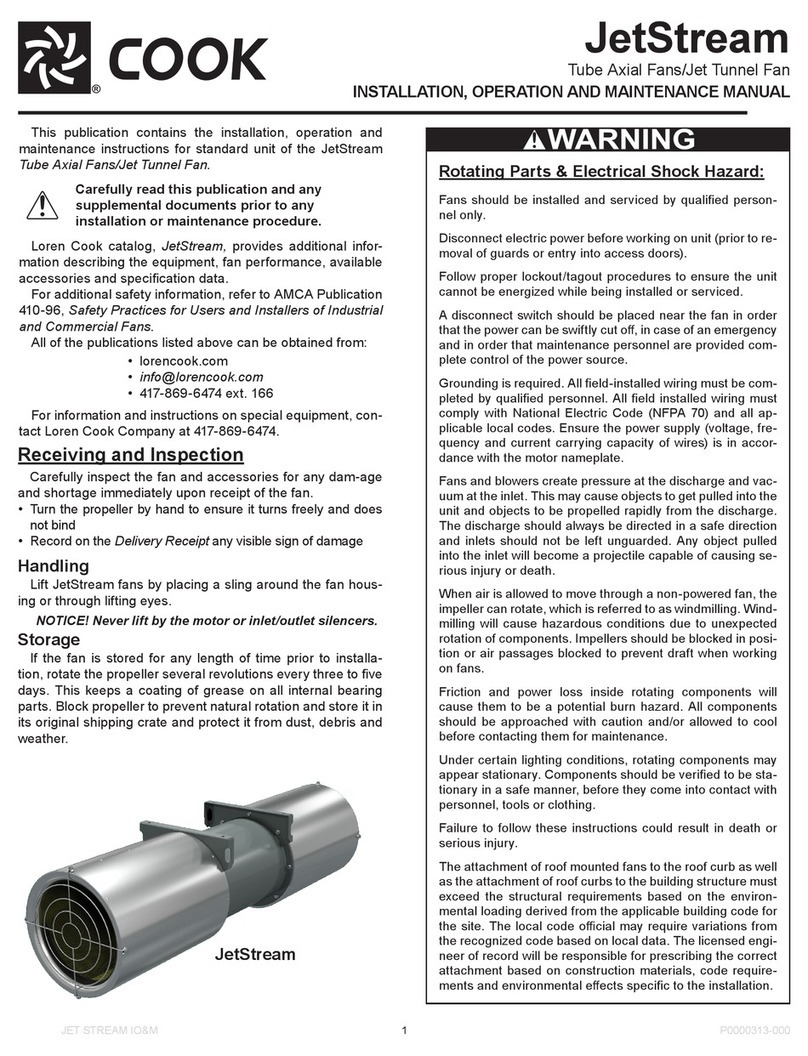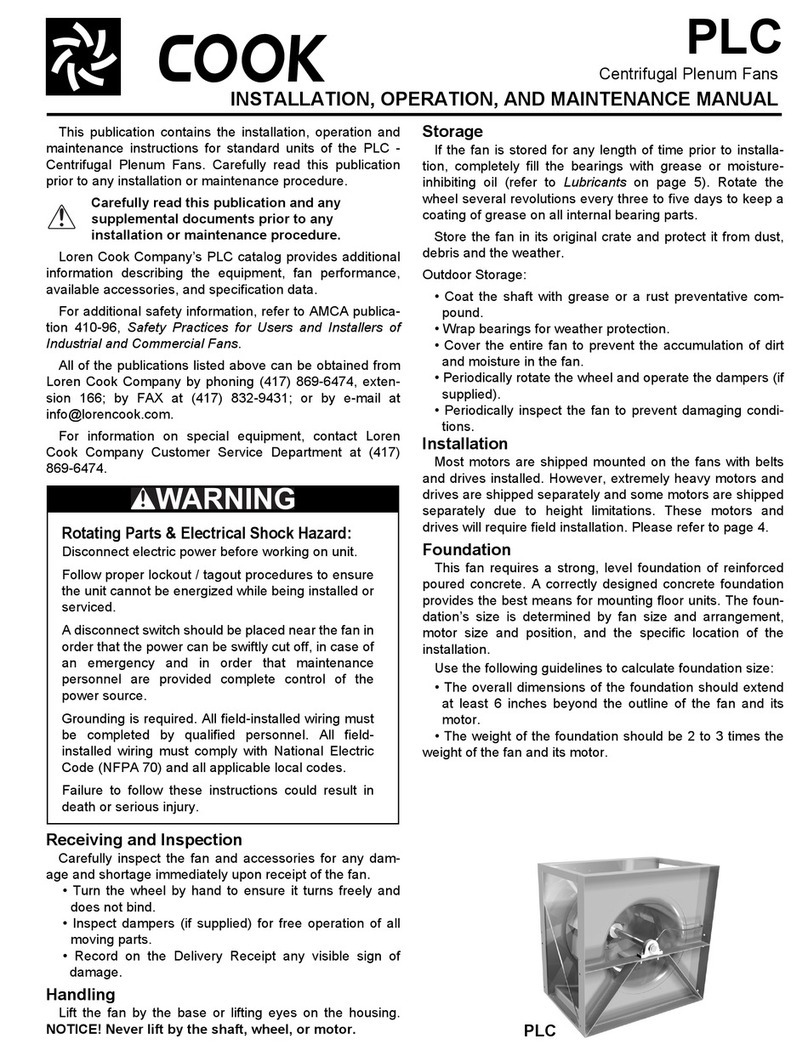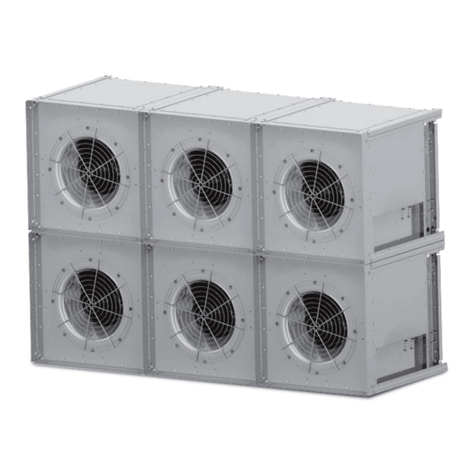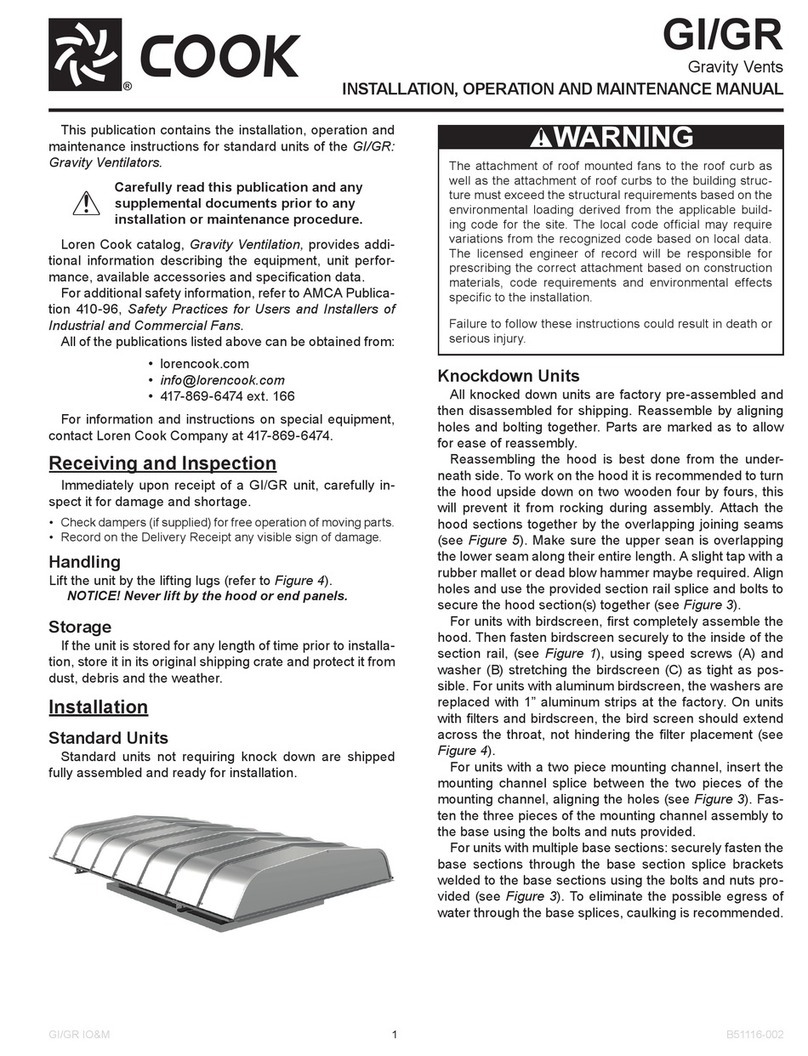
7QMX IO&M B51092-005
Exceptions to the greasing interval chart:
• Periodic Applications (any break of one week or more):
It is recommended that full lubrication be performed prior to
each break in operation
• Higher Temperature: It is recommended to halve the inter-
vals for every 30°F increase in operating temperature above
120°F not to exceed 230°F for standard bearings; high tem-
perature bearings (optional) can operate up to 400°F
• Vertical Shaft: It is recommended that the intervals should
be halved
Loren Cook Company uses petroleum lubricant in a lithium
base. Other types of grease should not be used unless the
bearings and lines have been ushed clean. If another type of
grease is used, it should be a lithium-based grease conforming
to NLGI grade 2 consistency.
A NLGI grade 2 grease is a light viscosity, low-torque, rust-
inhibiting lubricant that is water resistant. Its temperature
range is from -30°F to +200°F and capable of intermittent
highs of +250°F.
Motor Bearings
Motors are provided with prelubricated bearings. Any
lubrication instructions shown on the motor nameplate
supersede instructions below.
Motor bearings without provisions for relubrication will
operate up to 10 years under normal conditions with no
maintenance. In severe applications, high temperatures or
excessive contaminates, it is advisable to have the maintenance
department disassemble and lubricate the bearings after three
years of operation to prevent interruption of service.
For motors with provisions for relubrication, follow intervals
of the table below.
Relubrication Intervals
Service
Conditions
NEMA Frame Size
Up to and
Including 184T 213T-365T 404T and Larger
1800
RPM
and
Less
Over
1800
RPM
1800
RPM
and
Less
Over
1800
RPM
1800 RPM
and Less
Over
1800
RPM
Standard 3 yrs. 6 months 2 yrs. 6 months 1 yr. 3 months
Severe 1 yr. 3 months 1 yr. 3 months 6 months 1 month
Motors are provided with a polyurea mineral oil NGLI #2
grease. All additions to the motor bearings are to be with
a compatible grease such as Exxon Mobil Polyrex EM and
Chevron SRI.
The above intervals should be reduced to half for vertical
shaft installations.
Motor Services
Should the motor prove defective within a one-year period,
contact your local Loren Cook representative or your nearest
authorized electric motor service representative.
Changing Shaft Speed
All belt driven fans with motors up to and including 5HP are
equipped with variable pitch pulleys. To change the fan speed,
perform the following:
1. Loosen setscrew on driver (motor) pulley and remove key,
if equipped.
2. Turn the pulley rim to open or close the groove facing. If
the pulley has multiple grooves, all must be adjusted to
the same width.
3. After adjustment, inspect for proper belt tension.
Maximum RPM
Size QMX QMXHP QMXXP
Level 1 Level 2 Level 1 Level 2 Level 2 Level 3
90 -4000 -4000 - -
120 -3707 -4000 - -
135 -3295 -3876 - -
150 -2907 -3510 2920 3940
165 1975 2633 2368 3191 2654 3582
180 1811 2420 2171 2884 2433 3231
202 1610 2152 1935 2600 2168 2919
225 1449 1937 1737 2340 1947 2626
245 1330 1774 1595 2097 1767 2361
270 116 6 1623 1386 1819 1603 2134
300 1000 1465 1248 1679 1426 1921
330 856 1332 1134 1527 1296 1791
365 801 1204 1026 1381 1172 1604
402 709 1080 931 1252 1064 1458
445 612 988 841 1132 961 1312
490 602 897 759 1028 871 1202
540 523 813 693 912 792 1069
600 459 732 624 840 703 959
Speed Reduction
Open the pulley in order that the belt rides deeper in the
groove (smaller pitch diameter).
Speed Increase
Close the pulley in order that the belt rides higher in the
groove (larger pitch diameter). Ensure that the RPM limits of
the fan and the horsepower limits of the motor are maintained.
Pulley and Belt Replacement
1. Loosen and remove belts by adjusting motor mounting
plate.
2. Remove pulleys from their respective shafts.
3. Clean the motor and fan shafts.
4. Clean bores of pulleys and coat bores with heavy oil.
5. Remove grease, rust or burrs from pulleys and shafts.
6. Remove burrs from shaft by sanding.
7. Place fan pulley on fan shaft and motor pulley on motor
shaft. Damage to pulleys can occur when excessive force
is used in placing the pulleys on their respective shafts.
8. Tighten in place.
9. Install belts on pulleys and align as described in Belt and
Pulley Installation, page 3.
Bearing Replacement
The fan bearings are pillow block ball bearings.
1. Loosen and remove belts by adjusting motor mounting
plate.
2. Remove the bearing cover by removing the bolts around
the perimeter of the bearing cover. Do not remove fan
sheave yet.
3. Remove inlet cone by removing attaching bolts/nuts
around perimeter of the inlet plate.
4. Remove wheel by loosening setscrews and sliding o
shaft.
5. Record the location of the fan sheave from end of shaft,
and remove the sheave.
6. Record the distance from the bearing to the end of the
shaft.
7. Loosen setscrews on bearings and remove shaft.
8. Remove bearings from bearing base and replace with
new ones, noting the exact location of each; do not fully
tighten base bolts.
9. Slide shaft through bearings until shaft protrudes the
same amount as measured above. Tapping the inner race
of each bearing with a soft driver may be required. Do not
hammer the end of the shaft or the bearing housing.
10. Return setscrews to the same location as marked above
and tighten one setscrew on each bearing to half its
specied torque.

